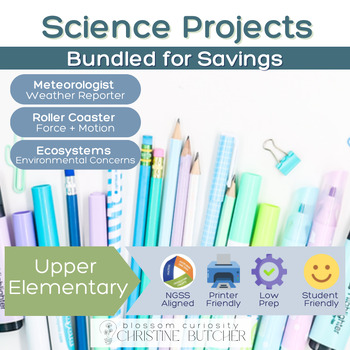Science PBL | Project and Problem Based Learning Bundle
Blossom Curiosity - Christine Butcher
932 Followers
Grade Levels
4th - 6th
Subjects
Resource Type
Standards
NGSS5-ESS2-2
NGSS3-5-ETS1-3
NGSS3-ESS2-1
NGSS3-LS4-3
NGSS5-ESS3-1
Formats Included
- Zip
Pages
28 pages
Blossom Curiosity - Christine Butcher
932 Followers
Products in this Bundle (3)
Description
Project/problem based learning is a great way to teach science and have your students learn through discovery. This bundle includes PBLs that teach force and motion, ecosystems, and meteorology.
In the force and motion PBL, students design a roller coaster to illustrate different key content vocabulary.
While doing the meteorology PBL, students research different locations in the world and create a weather report script.
In the ecosystem project they will research the causes and effects as well as problems and solutions of an environmental issue by examining the different factors that make up an ecosystem.
Each project includes part by part instructions, a student note page, rubric, and a peer review rubric.
Total Pages
28 pages
Answer Key
Rubric only
Teaching Duration
N/A
Report this resource to TPT
Reported resources will be reviewed by our team. Report this resource to let us know if this resource violates TPT’s content guidelines.
Standards
to see state-specific standards (only available in the US).
NGSS5-ESS2-2
Describe and graph the amounts of salt water and fresh water in various reservoirs to provide evidence about the distribution of water on Earth. Assessment is limited to oceans, lakes, rivers, glaciers, ground water, and polar ice caps, and does not include the atmosphere.
NGSS3-5-ETS1-3
Plan and carry out fair tests in which variables are controlled and failure points are considered to identify aspects of a model or prototype that can be improved.
NGSS3-ESS2-1
Represent data in tables and graphical displays to describe typical weather conditions expected during a particular season. Examples of data could include average temperature, precipitation, and wind direction. Assessment of graphical displays is limited to pictographs and bar graphs. Assessment does not include climate change.
NGSS3-LS4-3
Construct an argument with evidence that in a particular habitat some organisms can survive well, some survive less well, and some cannot survive at all. Examples of evidence could include needs and characteristics of the organisms and habitats involved. The organisms and their habitat make up a system in which the parts depend on each other.
NGSS5-ESS3-1
Obtain and combine information about ways individual communities use science ideas to protect the Earth’s resources and environment.





